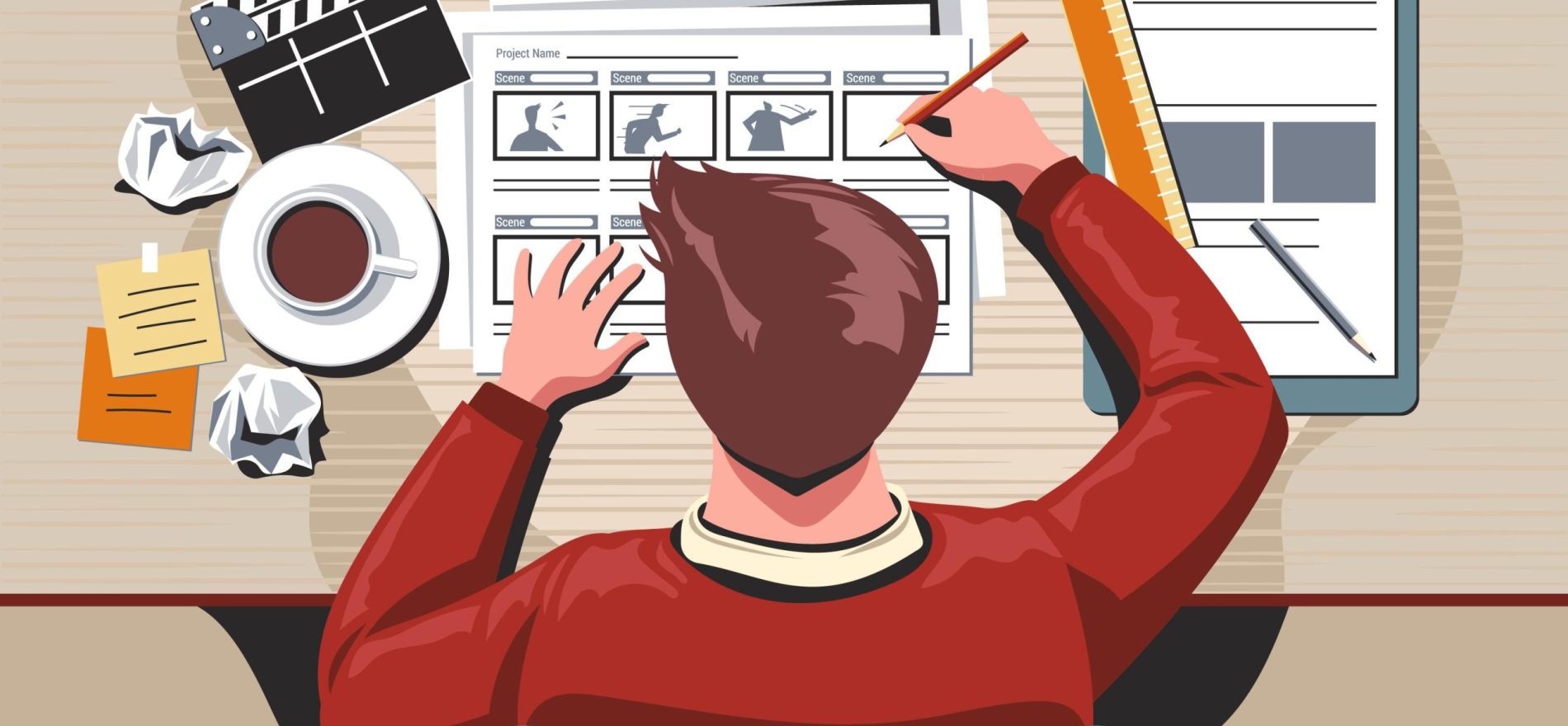All excellent films, cartoons, TV shows, and even video games begin with a concept and a storyboard. Since the 1930s, storyboarding has been utilized in the film industry to help all parties involved in a movie communicate their vision and direction.
We’ll go into more detail about animation storyboards in this post, including why it’s important for animation projects, how to make an animation storyboard and learn about storyboards in films and animation through our diploma in animation.
Table of Contents :
- What is an Animation Storyboard?
- Who Creates Animation Storyboards?
- Short History of Animation Storyboards
- Why Do Animators Use Storyboards?
- What are Animated Storyboards?
- Animation Storyboard Examples
- How to Become a Storyboard Artist for Animations
- Storyboard in Design Thinking
- Storyboard in Design Thinking Example
What is an Animation Storyboard?
An important tool in animation and filmmaking techniques is the storyboard. An animation storyboard or a film storyboard is an essential first step for every prospective filmmaker who has a concept in their brain. It should visually represent the main ideas and structural elements of the intended animation.
The storyboard is simply a collection of sketches that depict the major plot points in chronological order. This creates a visual link between the final animation and the screenplay or overall concept.
Each doodle often depicts an important shot or moment. These are called panels, and they can record technical information as well, typically in distinct boxes.
An animation storyboard panel must have the following items:
Frame: The storyboard artist will draw the scene in a rectangle box, approximately sketching what the spectator can see from that viewpoint.
Dialogues Notes: Any conversation that will be shown in the frame should be noted. Not exactly from the screenplay, but a brief synopsis of the main points.
Action Notes: Make notes whenever anything happens, such as pebbles crushing together or a car spinning out of control. might also mention the deeds of the characters.
Camera Shots: The storyboard panel should also capture the intended camera shots for each scene. From long shots to close up.
Who Creates Animation Storyboards?
However, many pros will collaborate with storyboard artists, sometimes known as board artists, to actualize their vision. A hobbyist director may well produce their own storyboard.
Traditionally, the director has been in charge of the project’s storyboard overall. Nevertheless, other crucial roles—from board artists to scriptwriters, from narrative editors to cinematographers—also contribute to the creation of the film.
Short History of Animation Storyboards
Storyboards have been used by animators and filmmakers since the early days of Hollywood. The first animation storyboards were really created by Walt Disney Studios in the 1930s.
Story creation is considered to have been a key component of animation filmmaking for Walt Disney, whose attitude allegedly led to the widespread use of storyboards in the industry.
Disney animator Webb Smith is said to have been the first to sketch scenarios on paper and arrange them next to one another, allegedly on a pin board. But the first time a full storyboard was used was in Disney’s 1933 short animation Three Little Pigs.
Disney still employs storyboards to “bring the director’s vision to life” even if that was 80 years ago.
Why Do Animators Use Storyboards?
There are many reasons 3d Animators use storyboards, ranging from cinematic conventions to checking whether something is viable within a production. Key reasons why they are often essential include:
Tried and tested method: Animators and filmmakers started using storyboards in the 1930s and continue to do so to this day. Though the technologies involved have changed hugely, the basic principle of an animated storyboard remains.
Captures a Vision: An animated movie lives mostly in the minds and imaginations of its creators, notably the director and author, up to the storyboard stage. The storyboard is the initial visual representation of the vision as a straightforward narrative.
Combines words and pictures: Words and images combine to create films. A writer and a story artist (or board artist, as they’re known at Disney) can work together at the storyboard stage to explore how the two media will mesh to reflect the director’s vision.
Can plan scenes and shots: A helpful tool for structuring and preparing a production is the storyboard. It may be used to divide the animation into scenes, with each scene’s unique camera shots bearing labels.
Provides a checklist: A well-written storyboard can also serve as a production-related shopping list. If you do it well, you’ll be aware of the number of scenes you have, the actors who are in them, any audio specifications, the list of shots that need to be taken, and more.
Build a reference document: Storyboards frequently go through several changes, which causes them to dramatically alter as documents. You may see the entire project from the first to the last shot by saving each version of your storyboard.
Allows for feedback: A filmmaker can utilize storyboarding to understand what works and what doesn’t, pinpoint specific difficulties and roadblocks, and get helpful input from others on the intended vision. This criticism could be just as important to the outcome of a feature film project as it might be for a student filmmaker talking to their professor.
What are Animated Storyboards?
A storyboard that has been simplified and animated is known as an animatic. This is where storyboard illustration comes into action as it’s simply a slideshow that shows each panel of your storyboard in action to better illustrate how it may function as an animation.
These are frequently used when a customer needs to see a storyboard, such as when an agency is making an animated commercial. Transitions between shots, character sounds, and speech can all be included in an animatic storyboard.
Animation Storyboard Examples
Looking at animation storyboard examples, particularly those that display the storyboard and the completed animation side by side, is one of the finest methods to learn more about storyboarding. These are a few storyboard examples for students which can help them understand the concept better.
Some of our favorite animation storyboard examples are shown here:
Luca and Alberto eat with Guilia and Massimo — Pixar Side-By-Side.
Guilia is having guests around for supper in this endearing Pixar cartoon. You can watch the storyboard running over the finished animation in this side-by-side video. You should learn some helpful advice on the required amount of information by watching.
UP ‘Married Life’ — Pixar Side-By-Side.
We can see the initial storyboard overlaid on the completed animation in this iconic (and heartbreaking) scene from the Pixar film UP called “Married Life.” This scene has a lot of activity, so it’s helpful to observe how the storyboard manages movement.
Frozen 2, Into the Unknown.
Similarly, to that, we can see the storyboard for the famous sequence in which the Oscar-nominated song Into the Unknown is featured. The shading techniques are detailed in the storyboard.
How to Become a Storyboard Artist for Animations
Mentioned below are the ways to become a storyboard artist for animation:
Getting Started
You need a concept for the animation you want to make before you can begin a storyboard, as well as the fundamental supplies for putting it up.
- Create your synopsis.
- Known your narrative structure.
- Know the action.
- List your camera requirements.
- Have your materials.
Sketching Your Animation Storyboards
Starting with paper and a pencil, sketch your storyboard. For each photo, you may start by roughing out a little thumbnail drawing. These oughts are to be depicted from the viewpoint of what the spectator would perceive on the screen. When you need to turn your head to observe something different, a fresh photo and thus a new thumbnail are required.
In order to go on to more detailed individual sketches on single sheets, which you can then arrange in the proper order on a whiteboard or wall, you may start by getting an overview perspective of the animation on one page.
Although a lot of animators still design storyboards by hand, more and more pros and amateurs are creating their frames using drawing applications.
Creating Your Storyboard Panels
It’s time to turn your preliminary sketches into panels once you’ve used them to develop a story. A storyboard panel is a rectangular frame with distinct boxes for dialogue and action notes that are drawn onto a piece of paper.
The size of the box will vary depending on whether you’re storyboarding for a wide-screen, TV, or film project. However, 4 x 3 inches is the norm. Prior to drawing and adding comments about speech or camera angles, etc., to the other boxes, you will first create the action of the scene within this box.
The scene number and panel number can be written in the designated areas at the top of each panel. Although genuine paper may be used to build panels, computer software is increasingly being used by both amateurs and experts to put them together.
Storyboard in Design Thinking
The user interface of the product will subsequently be created using the trip shown in the storyboard as a basis. Storyboards are a visual depiction of the user’s journey that does not correspond to the user interface of the product.
They are crucial to the process of design thinking. Prior to designing, developing, and launching actual products, team members must first do research on the issues that their target users face before condensing that information into a narrative. What is the user’s point of entry? What do they want to accomplish?
Utilizing a storyboard as a common starting point, product UX and functionality may be discussed and decided upon utilizing a visual representation of user research provided by a storyboard.
Storyboard in Design Thinking Example
Here is an illustration of a storyboard made using the design thinking methodology. The storyboard depicts a customer considering buying a conference ticket, buying that ticket, and then taking pleasure in the post-purchase experience, which includes an accessible mobile ticket and recommendations for dining and housing.
Related Courses

Fashion Design

Fashion Styling

Diploma In Art of Makeup

Diploma in Interior Design




















